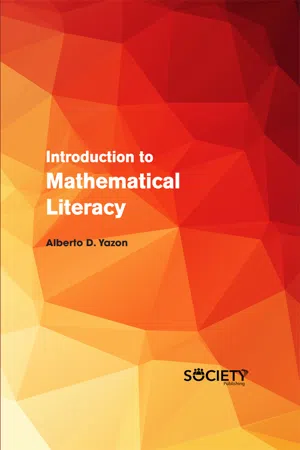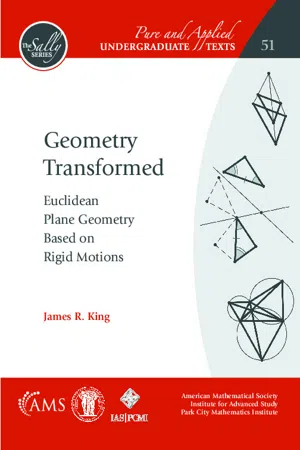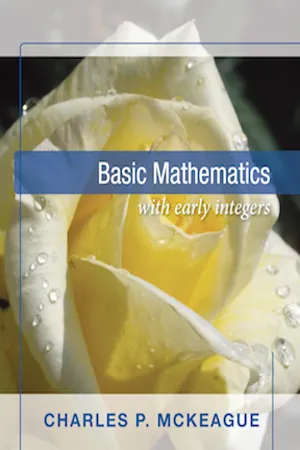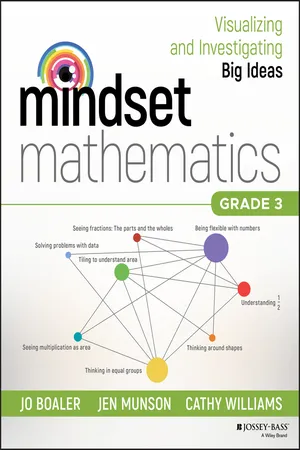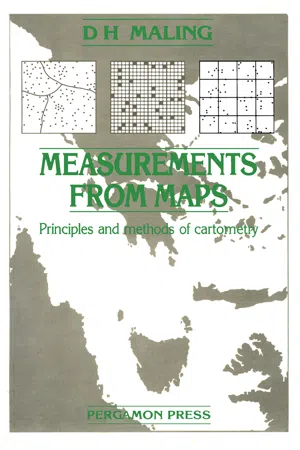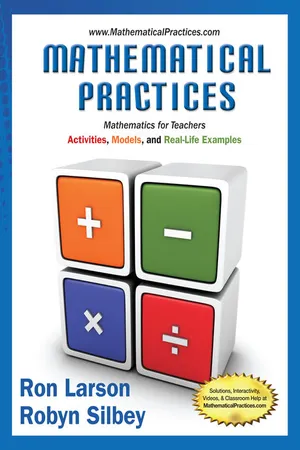Mathematics
Area of Rectangles
The area of a rectangle is the measure of the space inside the shape, calculated by multiplying the length and width of the rectangle. The formula for finding the area of a rectangle is A = l * w, where A represents the area, l is the length, and w is the width. This concept is fundamental in geometry and is used in various real-world applications.
Written by Perlego with AI-assistance
Related key terms
1 of 5
9 Key excerpts on "Area of Rectangles"
- Alan Sultan, Alice F. Artzt(Authors)
- 2017(Publication Date)
- Routledge(Publisher)
defined as length times width, is so that it will be consistent with those examples where we can divide the rectangles up into unit squares.This business of defining area troubles many people. Area is the amount of space taken up by a figure. How can we define what this is? It is no different from defining a foot and then measuring length with a ruler that represents a foot. A measurement of 1 foot is an object created by human minds. We could just as well have defined a measurement of length to be the distance from the tip of your nose to your bellybutton, called that a “bod,” and then measured how many bods there are in, say, a mile. The definitions we use for area, length, temperature, and so on are totally constructed by human beings. By establishing standard measures, we are able to make sense of what we observe.Having made the definition of the area of a rectangle as length times width, we can now easily derive the formulas for areas of other figures. Yes, we did say derive . It is quite remarkable that we can go from one figure to the next and find their areas, all from the area of a rectangle. What is especially nice is that, in doing so, we will see a direct interplay between algebra and geometry. The first few results are routine and will be gone through quickly, but soon some surprising results will emerge.Theorem 4.1 The area, A, of a right triangle with legs a and b, is given byA =.1 2a bProof . Start with right triangle ABD- eBook - PDF
- Alberto D. Yazon(Author)
- 2019(Publication Date)
- Society Publishing(Publisher)
With the help of multiplication of length to the breadth, the area of the rectangle which will be in square-units dimension. In the case of a square, the area will become length2. The major variation among square and rectangle is that the length and width are the same (Figure 4.18). Perimeter and Area 91 Figure 4.18: Block diagram of the area of a rectangle. Source: https://upload.wikimedia.org/wikipedia/commons/thumb/4/4a/Mo-ment_of_area_of_a_rectangle_through_the_base.svg/1024px-Moment_of_ area_of_a_rectangle_through_the_base.svg.png. 4.8.2. Perimeter of Rectangle It is already known that every shape is distinct from each other. In this way, the formula for the perimeters of geometric shapes also variates or fluctuates from one shape to another shape. Some of the common shapes, as well as formula for determining their perimeters, are as follows (Figure 4.19). Figure 4.19: Perimeter of the rectangle. Source: https://upload.wikimedia.org/wikipedia/commons/thumb/d/da/Perim-eterRectangle.svg/717px-PerimeterRectangle.svg.png. Rectangle: Rectangle is a four-sided polygon which is having two dimensions, that is length and breadth. Introduction to Mathematical Literacy 92 Perimeter of a rectangle = sum of four sides = AB + BC + CD + AD = length + breadth + length + breadth = 2 length + 2 breadth Perimeter of a rectangle = 2 × (length + breadth). 4.9. RHOMBUS 4.9.1. Perimeter of Rhombus Formula If any individual is having the consideration of Rhombus, it is a flat shape having the four same sides and four angles that are not necessarily of 90 ° . A rhombus is every so often called as a diamond or in the shape of a diamond. The total distance which is traveled end to end to the border of a rhombus is the perimeter of a rhombus. The rhombus can also be called a square because it fulfills all of the requirements or properties the same as compared to a rhombus has. - eBook - PDF
Geometry Transformed
Euclidean Plane Geometry Based on Rigid Motions
- James R. King(Author)
- 2021(Publication Date)
- American Mathematical Society(Publisher)
For computing the area of other shapes, there are two paths one can take. The most general path is to define area by filling up the shape as much as possible with small squares and adding up the areas of the small squares. Taking ever smaller squares gives a larger and more accurate approximation of the area, much as we did for squares with irrational sides above. Taking a limit will produce a value for the area, at least for familiar geometric shapes. The full development of this general approach requires technical arguments that would be distracting from the main thread of this book, so we will only touch on this approach a few times, assuming some statements without proof. Instead, we will take an older and geometrically more interesting approach, which is to cut shapes apart and re-assemble them into other shapes whose areas are known. Area of Rectangles. Shapes that can be assembled from squares, like the rectan-gle on the left in Figure 2, will have an area equal to the sum of the area of the squares, in this case 3×4 = 12 . If squares are subdivided into smaller squares, such as a division into 4 smaller congruent squares, then the small squares have an area of 1/4 for each small square. Since the shaded figure inside the rectangle on the right contains 24 such squares, it has an area of 6. If a rectangle has sides ? and ? that are rational, then by choosing common denominators, one can divide such rectangles into squares and get the formula that area equals ? × ? . Areas of Triangles and Parallelograms 163 Figure 2. Area of Rectangle and of Figure Built from Squares For the general case, a limit argument is not hard, but there are direct proofs using dissection and the area formula for a square. In Figure 3, a rectangle ? with sides ? and ? is placed in a rotationally symmetric way into a square with sides ? + ? . - eBook - PDF
- Tom Bassarear, Meg Moss(Authors)
- 2019(Publication Date)
- Cengage Learning EMEA(Publisher)
We can demonstrate this by covering each figure with 30 squares, each of which is 1 foot by Explorations Manual 9.6, 9.7 534 CHAPTER 9 Geometry as Measurement 1 foot (Figure 9.6). Another interesting question to consider is: which rectangle is “bigger” if we look at the perimeter only? They are equal sizes in area, but in perimeter the 6 by 5 feet rectangle is bigger. 10 ft 3 ft 6 ft 5 ft Figure 9.6 One of the models we used for multiplication in Chapter 3 was called the “area model.” Just as we can model 6 3 5 5 30 with the rectangle, also the area of a 6 by 5 rectangle is 30 squares. This is a nice connection between geometry and understanding operations. Although this may seem very simple and straightforward, many people are at least initially stumped when they try to explain what area means when the dimensions of a rectangle are not whole numbers—for example, when a rectangle is 3.5 centimeters by 2.5 centimeters. We say that the area of the rectangle is 8.75 square centimeters, because we know that the area of a rectangle is obtained by multiplying its length by its width. Can you explain what that 8.75 means, as if you were talking to a child who understands that in the previous problem, both sheets of plastic have an area of 30 square feet? Do this before reading on. . . . Figure 9.7 shows one way of explaining what it means to say that the area is 8.75 square centimeters: cutting up the rectangle and reassembling the pieces in a certain way. Do you under- stand this diagram? Did you explain the meaning of the 8.75 square centimeters in another way that also makes sense? Take some time to see if you can understand the diagrams below before you read my explanation. 3.5 cm 1 1 1 1 1 .5 1 1 1 .5 .5 .5 .5 .25 .5 .25 1 1 1 1 1 1 1 1 1 .5 .5 .5 .5 .5 .5 2.5 cm Figure 9.7 We can partition the rectangle in a manner similar to the way we used partitioning in the mul- tiplication of fractions and decimals. - eBook - PDF
- Charles P. McKeague(Author)
- 2011(Publication Date)
- XYZ Textbooks(Publisher)
Geometry Suppose a rectangle has a perimeter of 12 inches. If the length and the width are whole numbers, give all the possible values for the width. As- sume the width is shorter side and the length is the longer side. 32. Geometry Suppose a rectangle has a perimeter of 10 inches. If the length and the width are whole numbers, give all the possible values for the width. As- sume the width is the shorter side and the length is the longer side. 33. Geometry If a rectangle has a perimeter of 20 feet, is it possible for the rect- angle to be a square? Explain your answer. 34. Geometry If a rectangle has a perimeter of 10 feet, is it possible for the rect- angle to be a square? Explain your answer. 35. Geometry A rectangle has a perimeter of 9.5 inches. If the length is 2.75 inches, find the width. 36. Geometry A rectangle has a perimeter of 11 inches. If the width is 2.5 inches, find the length. Getting Ready for the Next Section Simplify each expression. Round your answers to the nearest hundredth. 37. 1 } 2 ? 6 ? 3 39. 1 } 2 1 2 5 } 8 21 1 1 } 4 2 41. 3.14(14.5) 2 43. 144 2 36(3.14) 38. 1 } 2 ? 4 ? 2 40. 1 } 2 (6.6)(3.3) 42. 3.14(5) 2 44. 100 2 25(3.14) 8.2 Area 449 8.2 Recall that the area of a flat object is a measure of the amount of surface the ob- ject has. The area of the rectangle below is 8 square centimeters, because it takes 8 square centimeters to cover it. Area As we have noted previously, the area of this rectangle can also be found by mul- tiplying the length and the width. Area 5 (length) ? (width) 5 (4 centimeters) ? (2 centimeters) 5 (4 ? 2) ? (centimeters ? centimeters) 5 8 square centimeters From this example, and others, we conclude that the area of any rectangle is the product of the length and width. Here are the most common geometric figures along with the formula for the area of each one. The only formulas that are new to us are the ones that accom- pany the parallelogram and the circle. - Jo Boaler, Jen Munson, Cathy Williams(Authors)
- 2018(Publication Date)
- Jossey-Bass(Publisher)
Discuss the patterns students notice in the class display, the evidence students have collected, and any revisions they want to make to the conjectures based on this evidence. Discuss the relationship between area and perimeter that they can see in the data.- Class display of rectangles
- Conjectures chart and markers
To the Teacher
Up to this point, we have been careful to introduce perimeter and area at different times and to build conceptual understanding of each. Perimeter is the distance around an object or shape, and we hope students can call up a physical memory of encircling an object with string whenever they think about perimeter. Area is the number of square units needed to cover a shape or surface, and we hope that students have a physical memory of tiling geoboards and constructing rectangles with square tiles. In this investigation, we explore the relationship between perimeter and area as two attributes of shapes.It is important to make this investigation very “mistake-friendly.” Students will certainly make mistakes: errors in counting, drawing, cutting and taping, labeling, and organizing. They may make several rectangles with the same area, but not all the possible rectangles. They may add incorrectly, especially if exploring shapes with a large area, such as 32 square units. In the first discussion, encourage students to find and address any errors that crop up, and simply point out how much sense making students must be doing to identify evidence that doesn't make sense. Celebrate the process of wrangling so much information to try to find patterns and think about relationships.Activity
Launch
Launch this investigation by showing students a set of 12 square tiles scattered on the document camera. Ask students, What rectangles can I make using all of these tiles? Give students a moment to turn and talk to a partner. Collect some ideas and have students come up to move the tiles to create a couple of different rectangles. It will be useful if you can show more than one rectangle at the same time.- eBook - PDF
- John Peterson, Robert Smith(Authors)
- 2019(Publication Date)
- Cengage Learning EMEA(Publisher)
437 Geometric Figures: Areas and Volumes 6 OBJECTIVES After studying this unit you should be able to ● ● Express given customary area measures in larger and smaller units. ● ● Express given metric area measures in larger and smaller units. ● ● Convert between customary area measures and metric area measures. ● ● Compute areas, lengths, and widths of rectangles. ● ● Compute areas, bases, and heights of parallelograms. ● ● Compute areas, both bases, and heights of trapezoids. ● ● Compute areas of more complex figures (composite figures) that consist of two or more common polygons. As previously stated, in machine technology linear or length measure is used more often than area and volume measure. However, the ability to compute areas and volumes is required in determining job-material quantities and costs. Often, before a product is manufactured, part weights are computed. Volumes of simple geometric figures and combinations of figures (composite figures) must be calculated before weights can be determined. Section 6 presents area and volume measure of two-dimensional and three-dimensional geometric figures and practical area and volume applications. Areas of Rectangles, Parallelograms, and Trapezoids UNIT 59 CUSTOMARY AND METRIC UNITS OF SURFACE MEASURE (AREA) A surface is measured by determining the number of surface units contained in it. A surface is two dimensional. It has a length and width, but no thickness. Both length and width must be expressed in the same unit of measure. Area is computed as the SECTION SIX 438 SECTION 6 GEOMETRIC FIGURES: AREAS AND VOLUMES product of two linear measures and is expressed in square units. For example, 2 inches 3 4 inches 5 8 square inches (8 sq in. or 8 in. 2 ). The surface enclosed by a square that is 1 inch on a side is 1 square inch (1 sq in. or 1 in. 2 ). The surface enclosed by a square that is 1 foot on a side is 1 square foot (1 sq ft or 1 ft 2 ). - eBook - PDF
Measurements from Maps
Principles and Methods of Cartometry
- D H Maling(Author)
- 2016(Publication Date)
- Butterworth-Heinemann(Publisher)
The Area of a Rectangle In Fig. 16.1(b) the rectangle ABCD has the sides AB = a and BC = b. Quite simply. A = a-b (16.7) The Area of a Parallelogram In Fig. 16.1(c) the figure has side AB = a and BC = b. Also h is the length of the perpendicular to one pair of the parallel sides. Then A = ah (16.8) Also A = abs'mB (16.9) The Area of a Rhombus The length of each side of the figure is equal to a. In Fig. 16.1(d) the lengths of the diagonals, AC and BD are also known, A = {-(AC-BD)-sin Β (16.10) Also, as a special case of (16.9) A = a 2 s'mB (16.11) The Area of a Trapezoid In Fig. 16.1 (e) the lengths of the pair of parallel sides A Β and CD are known; so, too, is the perpendicular distance, ft, between them. Then A={h(AB + CD) (16.12) 330 Measurements from Maps The Area of Any Quadrilateral The length of the diagonal BD is known; so, too are the length of the two perpendiculars h x and h 2 joining the diagonal BD to A and DC respectively. A = 2 ^BD(h l + h 2 ) (16.13) If the area of the figure is to be determined from measurement on a map or plan, it is usually preferable to employ the formulae which make use of linear measurements only, for these can be measured more accurately than angular measurements. An exception to this rule occurs when special equipment intended to measure angles is used. The Coradi Digimeter Model D M P , to be described later, is a case in point, because this measures polar coordinates. Similarly, if angular measurements have been made in the field, there is little objection to the use of them arid equations such as (16.2)—(16.4) and (16.9) may be employed. DETERMINATION OF THE AREA OF THE FRAMEWORK OF A PARCEL The geometrical method of determining the area of the framework of a parcel comprises subdivision of the parcel into a network of simple geometrical figures, measuring certain elements of these figures, calculating the individual areas of them and finally combining the results. - eBook - PDF
Mathematical Practices, Mathematics for Teachers
Activities, Models, and Real-Life Examples
- Ron Larson, Robyn Silbey(Authors)
- 2014(Publication Date)
- Cengage Learning EMEA(Publisher)
Find the perimeter and area of the rectangle by using formulas. Count the numbers of linear units and square units to check your answers. 8. Perimeter and Area of a Rectangle The distance between 2 horizontal dots or 2 vertical dots is 1 unit. Find the perimeter and area of the rectangle by using formulas. Count the numbers of linear units and square units to check your answers. 9. Perimeter and Area of a Rectangle Find the perimeter and area of the rectangle. 80 ft 25 ft 11.2 Exercises Free step-by-step solutions to odd-numbered exercises at MathematicalPractices.com. Free step-by-step solutions to odd-numbered exercises at MathematicalPractices.com. Copyright 2014 Cengage Learning. All Rights Reserved. May not be copied, scanned, or duplicated, in whole or in part. Due to electronic rights, some third party content may be suppressed from the eBook and/or eChapter(s). Editorial review has deemed that any suppressed content does not materially affect the overall learning experience. Cengage Learning reserves the right to remove additional content at any time if subsequent rights restrictions require it. Section 11.2 Perimeters and Areas of Polygons 429 10. Perimeter and Area of a Rectangle Find the perimeter and area of the rectangle. 3.5 m 1.2 m 11. Area of a Parallelogram The distance between 2 horizontal dots or 2 vertical dots is 1 unit. Find the area of the parallelogram by using a formula, and then by counting the number of square units. Explain how you counted the number of square units. 12. Area of a Trapezoid The distance between 2 horizontal dots or 2 vertical dots is 1 unit. Find the area of the trapezoid by using a formula, and then by counting the number of square units. Explain how you counted the number of square units. 13. Area of a Parallelogram Find the area of the parallelogram. 8 cm 10 cm 9 cm 14. Area of a Parallelogram Find the area of the parallelogram. 21 ft 24 ft 21 ft 15. Area of a Trapezoid Find the area of the trapezoid.
Index pages curate the most relevant extracts from our library of academic textbooks. They’ve been created using an in-house natural language model (NLM), each adding context and meaning to key research topics.

